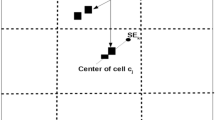Abstract
This paper introduces how to fuse the data acquired from different sensors available in commodity smartphones to build accurate location-based services, pursuing a good balance between accuracy and performance. Using scale invariant features from the images captured using the smartphone camera, we perform a matching process against previously obtained images to determine the current location of the device. Several refinements are introduced to improve the performance and the scalability of our proposal. Location fingerprinting, based on IEEE 802.11, will be used to determine a cluster of physical points, or zone, where the device seems to be according to the received signal strength. In this way, we will reduce the number of images to analyze to those contained in the tentative zone. Additionally, accelerometers will be also considered in order to improve the system performance, by means of a motion estimator. This set of techniques enables a wide range of new location-based applications.
Access this chapter
Tax calculation will be finalised at checkout
Purchases are for personal use only
Preview
Unable to display preview. Download preview PDF.
Similar content being viewed by others
References
Arai, I., Horimi, S., Nishio, N.: Wi-Foto 2: Heterogeneous device controller using Wi-Fi positioning and template matching. In: Proc. Pervasive 2010 (2010)
Arya, S., Mount, D.M., Netanyahu, N.S., Silverman, R., Wu, A.Y.: An optimal algorithm for approximate nearest neighbor searching in fixed dimensions. In: ACM-SIAM Symposium on Discrete Algorithms, pp. 573–582 (1994)
Azizyan, M., Constandache, I., Roy Choudhury, R.: SurroundSense: Mobile Phone Localization via Ambience Fingerprinting. In: Proc. of the 15th MOBICOM, pp. 261–272 (2009)
Bahl, P., Padmanabhan, V.N.: RADAR: An In-Building RF-based User Location and Tracking System. In: Nineteenth Annual Joint Conference of the IEEE Computer and Communications Societies, vol. 2, pp. 775–784 (2000)
Beis, J., Lowe, D.G.: Shape indexing using approximate nearest-neighbour search in high-dimensional spaces. In: Proc. CVPR 1997, pp. 1000–1006 (1997)
Block, H.D.: The perceptron: a model for brain functioning. I, pp. 135–150. MIT Press, Cambridge (1988)
Chandrasekaran, G., Ergin, M.A., Yang, J., Liu, S., Chen, Y., Gruteser, M., Martin, R.P.: Empirical Evaluation of the Limits on Localization Using Signal Strength. In: Proc. SECON 2009, pp. 333–341 (2009)
Haeberlen, A., Flannery, E., Ladd, A.M., Rudys, A., Wallach, D.S., Kavraki, L.E.: Practical Robust Localization over Large Scale 802.11 Wireless Networks. In: Proc. MOBICOM 2004, pp. 70–84 (2004)
Hattori, K., Kimura, R., Nakajima, N., Fujii, T., Kado, Y., Zhang, B., Hazugawa, T., Takadama, K.: Hybrid indoor location estimation system using image processing and WiFi strength. In: Proc. WNIS 2009, pp. 406–411 (2009)
Hile, H., Borriello, G.: Positioning and orientation in indoor environments using camera phones. IEEE Computer Graphics Applications 28, 32–39 (2008)
Konolige, K., Chou, K.: Markov Localization using Correlation. In: Proc. IJCAI 1999, pp. 1154–1159 (1999)
Lemelson, H., Kjærgaard, M.B., Hansen, R., King, T.: Error Estimation for Indoor 802.11 Location Fingerprinting. In: Choudhury, T., Quigley, A., Strang, T., Suginuma, K. (eds.) LoCA 2009. LNCS, vol. 5561, pp. 138–155. Springer, Heidelberg (2009)
Lowe, D.G.: Object Recognition from Local Scale-Invariant Features. In: Proc. ICCV 1999, pp. 1150–1157 (1999)
Lowe, D.G.: Distinctive Image Features from Scale-Invariant Keypoints. International Journal of Computer Vision 60, 91–110 (2004)
Miyaki, T., Yamasaki, T., Aizawa, K.: Tracking persons using particle filter fusing visual and WiFi localizations for widely distributed camera. In: Proc. ICIP 2007, pp. 225–228 (2007)
Mount, D.M., Arya, S.: Ann a library for approximate nearest neighbor searching. In: 2nd CGC Workshop on Computational Geometry (1997)
Mulloni, A., Wagner, D., Barakonyi, I., Schmalstieg, D.: Indoor Positioning and Navigation with Camera Phones. IEEE Pervasive Computing 8, 22–31 (2009)
Park, J.G., Charrow, B., Curtis, D., Battat, J., Minkov, E., Hicks, J., Teller, S., Ledlie, J.: Growing an organic indoor location system. In: Proc. MobiSys 2010, pp. 271–284 (2010)
Sohn, T., Li, K.A., Lee, G., Smith, I., Scott, J., Griswold, W.G.: Place-Its: A Study of Location-Based Reminders on Mobile Phones. In: Beigl, M., Intille, S.S., Rekimoto, J., Tokuda, H. (eds.) UbiComp 2005. LNCS, vol. 3660, pp. 232–250. Springer, Heidelberg (2005)
Turcot, P., Lowe, D.: Better matching with fewer features: The selection of useful features in large database recognition problems. In: Proc. ICCV 2009 (2009)
Vedaldi, A., Soatto, S.: Features for recognition: viewpoint invariance for non-planar scenes. In: Proc. ICCV 2005, pp. 1474-1481 (2005)
Werner, M., Kessel, M., Marouane, C.: Indoor Positioning Using Smartphone Camera. In: Indoor Positioning Indoor Navigation (IPIN) (September 2011)
Author information
Authors and Affiliations
Editor information
Editors and Affiliations
Rights and permissions
Copyright information
© 2012 ICST Institute for Computer Science, Social Informatics and Telecommunications Engineering
About this paper
Cite this paper
Ruiz-Ruiz, A.J., Canovas, O., Rubio Muñoz, R.A., Lopez-de-Teruel Alcolea, P.E. (2012). Using SIFT and WiFi Signals to Provide Location-Based Services for Smartphones. In: Puiatti, A., Gu, T. (eds) Mobile and Ubiquitous Systems: Computing, Networking, and Services. MobiQuitous 2011. Lecture Notes of the Institute for Computer Sciences, Social Informatics and Telecommunications Engineering, vol 104. Springer, Berlin, Heidelberg. https://doi.org/10.1007/978-3-642-30973-1_4
Download citation
DOI: https://doi.org/10.1007/978-3-642-30973-1_4
Publisher Name: Springer, Berlin, Heidelberg
Print ISBN: 978-3-642-30972-4
Online ISBN: 978-3-642-30973-1
eBook Packages: Computer ScienceComputer Science (R0)




